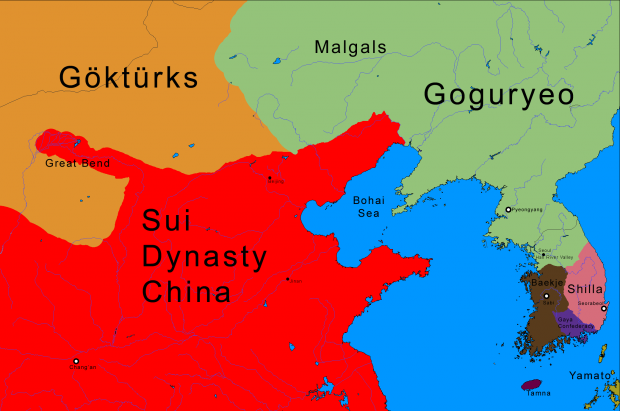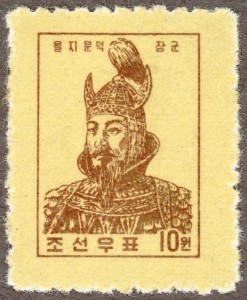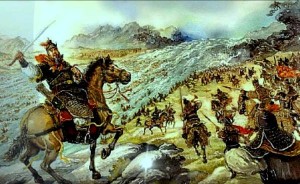An Astonishing Victory: Battle of Salsu
Battle of Salsu might be accepted as one of the most destructive and astonishing wars in the military history. The expansionist and dominant policy of China aimed at to destroy a Korean power, Goguryeo, which was accepted as a potential threat on its northern borders. China tried to suppress the domestic rebellions with new victories and continued to expand its territories toward to north by sustainable wars. At the same time, China was on the advantageous side because of the available problems among Korean kingdoms which were struggling against each other. But Chinese emperor wasn’t aware of a forthcoming tragedy while he was preparing an army which included one-million soldiers at the year of 612.
In the late of the fifth century, the Goguryeo Kingdom which ruled the northern parts of the Korean peninsula, reached out to Manchuria when China had focused on domestic stability and the dangers of the Turkish invasion in near abroad. It was a new potential threat for China as addition to other neighbours. Goguryeo was a transition point of the Korean peninsula to Asia because Silla, Baekje and Gaya Confederation were ruling the rest of the Korean peninsula.
The Sui-Goguryeo Struggle
The Salsu Victory is the second part of the series of wars between Goguryeo and China. These wars had been called as Sui-Goguryeo Wars and occurred between 598 and 614. These struggles negatively affected the Chinese rule in the region and caused the collapse of Sui Dynasty while Korean powers enlarged the area of influence.
The war which occurred between Goguryeo and China to keep control in Liaodong peninsula caused the extirpation of all Chinese soldiers.
During the period of Emperor Yang of Sui who ruled the country between 604 and 618, China aimed at to debilitate Goguryeo. China could enter to Korean peninsula after defeating Goguryeo and can easily destroy the powers of Silla and Baekje. Goguryeo was a guarantee to the peninsula for its buffer position and China will take care of its important location in coming years.
The Turkish-Korean Cooperation which Annoyed China
The great progress had been provided during the Sui Dynasty period between 589 and 618. Emperors Wen, Yang and Gong of Sui consolidated the public institutions, agricultural developments as addition to the continuous construction of the Great Wall and Great Channel projects. But the excessive costs of the struggles against Korea, have weakened the empire.
The Turkish invasions were fundamental problems during the period of Yang who came to the power after the Emperor Wen who achieved some military operations around Yangtze River and Eastern Chinese Sea. The strong cooperation between Goguryeo and Gokturks was also a big question for the empire. Chinese emperors Wen and Yang demanded the stop Goguryeo’s violations on the borders by creating collaboration with Turkish tribes.
Goguryeo which created good relations with old Chen dynasty and other separated Chinese administration changed its position after the foundation of Sui dynasty. Liaodong peninsula was now more valuable than past. Goguryeo was aiming at to expand its borders for turning into be an empire.
Relations Between Gokturks and Goguryeo
In 598, the first Chinese attack wasn’t successful because of diseases and terrible climate conditions. Emperor Yang who came to the throne in 604, demanded Goguryeo to cancel its collaboration with Gokturks. Yami Khagan (Kimin) who was in a conflict with Western Gokturk Khaganate, assured Chinese support to create chaos among Gokturks. It was hard for the Gokturks to make any collaboration with other regional rulers. But some reports about a possible cooperation between Goguryeo and Eastern Gokturk Khaganate’s leader Yami Khaghan and Sipi Khaghan were sending
Preparation For the Great War
Emperor Yang who tried to gain time with some diplomatic manoeuvres, started a preparation for a war after the construction of Great Channel which is a link between southern and northern parts of the country. From the first months of 611, he created a magnificent army to conquer Pyongyang, Goguryeo’s capital, by collecting people from the southern part under the law of compulsory military service along with food supplement. It was possible to keep control in Pyongyang if the empire conquers the Liaodong peninsula. Up to 1.130.000 soldiers were agglomerated near to regions around Manchuria. The maneuver ability of the army which need to reach Liaodong that is 500 kilometre away from them, was unsatisfactory.
Goguryeo pulled back its soldiers to the eastern side of Liao River which locates in Liaodong peninsula. The weather condition was useful for Goguryeo, strong ice-field melted. Chinese army needed to construct bridges to pass the river ways.
There were numerous ambushes which were prepared by Goguryeo soldiers for Chinese army which was moving toward Goguryeo territory. Some soldiers were killed in castle areas and some of them in swamps. Thus Chinese emperor had to change the tactics. Some sources give the information about help of some Turkish and Chinese tribes to Goguryeo forces. Chinese army couldn’t conquer even one of the Goguryeo castle during the six-month-length siege. If some battalions could conquer, they have been killed in the castle.
Sea Attack to Korea
Emperor Yang who wants to reach Korea quickly, put new tactics to increase the moral level of soldiers which were tired of long-term land siege. While the land army was slowly walking, he ordered to enter Taedong River which flows through the heart of Goguryeo with the support of 200.000 soldiers. Chinese soldiers achieved and entered to Pyongyang easily. But the city was empty and the army faced a sudden attack of Goguryeo from the northeast. Chinese army fell back because of this attack. The early success couldn’t work.
On the other side, the land army entered to Yalu River which locates in the north. There was a question about the protection of new soldier and food supplement. Korean ambushes were main problems for the Chinese army. Thus commanders ordered soldiers to carry their own food supplements instead of workers and servants. This order was a difficult issue for soldiers who don’t accept to carry them. A starvation period started quickly. It caused the deaths and illness.
The Legend Commander Eulji Mundeok
Goguryeo king was preparing to offer a ceasefire and he ordered commander Eulji Mundeok who commissioned as field marshal. Chinese army did not accept the offer and tried to capture Eulji Mundeok but the plan was failed. The available situation was unintelligible. The army was divided into several troops and their communication with the main commanders was cut. They did not know how to act when Eulji Mundeok came.
The main purpose of Eulji was to gain time while sending Korean scouts to capital and preparing new ambushes on the way. His famous poem to Chinese commanders even today is so popular.
Your divine plans have plumbed the heavens/Your subtle reckoning has spanned the earthYou win every battle, your military merit is great/Why then not be content and stop the war?
(신책구천문/묘산궁지리/전승공기고/지족원운지)
He was deceiving the Chinese army with promises and cynical poems. The tired army was divided again and mulishly continued the way to conquer the capital. But geographic difficulties negatively affected them. The connection was lost among the troops and Goguryeo started to extinguish all of them.
Annihilation of Chinese Army
The Chinese army was frequently attacked by Goguryeo when it was so close to Pyongyang. 300.000 soldiers arrived at Salsu River (today Chongchon, 청천강). The water level in the riverbed was very low. Actually, Goguryeo cut off the water flow from a dam.
But Eulji Mundeok ordered to open the dam gate while Chinese soldiers were passing the middle of the river. Water created a flow impact and caused to drown most of them and others escaped. Chinese and Korean sources give the number of alive soldiers approximately 2700.
This victory was a symbol of Eulji Mundeok for his struggle against China. His genius and literary ability are the most important sides of him.
Emperor Yang was furious with the defeat and decided to attack Goguryeo again. He attacked for two times more one and two years after the defeat. But internal political pressures did not let him continue. Sui Dynasty which was one of the most effective ones in Chinese history with its valuable projects dramatically collapsed in 618 when Yang died after spending the energy on the battles.
Goguryeo became a strong kingdom in coming years but accepted the rule of Silla under the name of Unified Silla.
The Dam Which Killed Chinese Soldiers
The tactic of the dam of Eulji Mundeok is accepted as an amazing and extraordinary example in military history. According to some research, Mundeok constructed this dam as an ambush against a possible Chinese attack on Korea, not for agricultural projects. If we look at details, we see a general strategy of Mundeok such as wasting the time of Chinese army and dividing them from the first walk in Manchuria. He applied to strategic and tactic games. Ceasefire offer was the last part of the game for a great preparation for the last strike. This victory is an important one in Korean history.
History repeats itself in 1950
It is interesting that a new war occurred in the same place of Chongchon river as Battle of the Chongchon River. United Nations forces with he collaboration of US, Turkey, and the UK against China clashed in this historical area. China decisively won the battle. It seems that it was a revenge of Salsu Battle. Historical deja vu appeared for Korea.
Sources:




























































